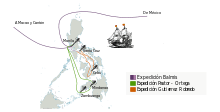Balmis Expedition


The Balmis Expedition (1803–1806) was a three-year mission to the Americas led by Dr. Francisco Javier de Balmis with the aim of vaccinating millions against smallpox. Vaccination, a much safer way to prevent smallpox than older methods such as inoculation, had been introduced by the English physician Edward Jenner in 1798.
The Balmis expedition set off from A Coruña on 30 November 1803. It may be considered the first international health-care expedition in history.[1][2] The discoverer of the vaccine, Edward Jenner himself, wrote, "I don’t imagine the annals of history furnish an example of philanthropy so noble, so extensive as this."
King Charles IV of Spain supported his royal doctor Balmis, since his daughter María Luísa had suffered the illness. The expedition sailed on Maria Pita and carried 22 orphan boys (eight to ten years old) as successive carriers of the disease, Balmis, a deputy surgeon, two assistants, two first-aid practitioners, three nurses, and Isabel López de Gandalia, the rectoress of Casa de Expósitos, a A Coruña orphanage.[3]
The mission took the vaccine to the Canary Islands, Colombia, Ecuador, Peru, Mexico, the Philippines and China.[4] The ship carried also scientific instruments and translations of the Historical and Practical Treatise on the Vaccine by Moreau de Sarthe to be distributed to the local vaccine commissions to be founded.
In Puerto Rico, the local population was already inoculated from the Danish colony of Saint Thomas. In Venezuela, the expedition divided at La Guayra. José Salvany, the deputy surgeon, went toward today's Colombia and the Viceroyalty of Peru (Venezuela, Panama, Colombia, Ecuador, Peru, Chile, and Bolivia). They took seven years and the toils of the voyage brought death to Salvany (Cochabamba, 1810). Balmis went to Caracas and later to Havana. The local poet Andrés Bello wrote an ode to Balmis. In Mexico, Balmis took 25 orphans to maintain the infection during the crossing of the Pacific. In the Philippines, they received help from the Catholic church. Balmis sent most of the expedition back to Mexico while he went on to China, where he visited Macau and Canton. On his way back to Spain, Balmis convinced the authorities of Saint Helena (1806) to be inoculated.
Julia Alvarez wrote a fictional account of the expedition from the perspective of its only female member in Saving the World.
References
- ↑ Carlos Franco-Paredes; Lorena Lammoglia; José Ignacio Santos-Preciado (2005). "The Spanish Royal Philanthropic Expedition to bring Smallpox vaccination to the New World and Asia in the 19th Century". Clinical Infectious Diseases. Oxford Journals. 41 (9): 1285–1289. doi:10.1086/496930.
- ↑ La Coruña: A progressive city, historical information as part the official web site for the city of La Coruña. Verified availability 2005-03-03.
- ↑ McIntyre, John W.R. MB BS; and Houston, C. Stuart MD (1999). Medicine in Canada: Smallpox and its control in Canada. Canadian Medical Association Journal 161(12), 1543-1547. PMID 10624414.
- ↑ de Romo, Ana Cecilia Rodríguez (1997). Inoculation in the 1799 smallpox epidemic in Mexico: Myth or real solution?. Antilia:Spanish Journal of History of Natural Sciences and Technology.
External links
- The Balmis-Salvany Smallpox Expedition: The First Public Health Vaccination Campaign in South America
- En el nombre de los Niños. Real expedición Filantrópica de la Vacuna 1803-1806. Spanish language PDF book by the Spanish Pediatry Association.
- An account of the expedition